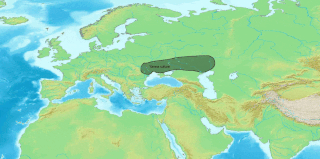Related Research Articles

In phonology, an allophone is one of multiple possible spoken sounds – or phones – used to pronounce a single phoneme in a particular language. For example, in English, the voiceless plosive and the aspirated form are allophones for the phoneme, while these two are considered to be different phonemes in some languages such as Central Thai. Similarly, in Spanish, and are allophones for the phoneme, while these two are considered to be different phonemes in English.

The Brittoniclanguages form one of the two branches of the Insular Celtic language family; the other is Goidelic. It comprises the extant languages Breton, Cornish, and Welsh. The name Brythonic was derived by Welsh Celticist John Rhys from the Welsh word Brython, meaning Ancient Britons as opposed to an Anglo-Saxon or Gael.

Manx, also known as Manx Gaelic, is a Gaelic language of the insular Celtic branch of the Celtic language family, itself a branch of the Indo-European language family. Manx is the historical language of the Manx people.
In phonetics, a plosive, also known as an occlusive or simply a stop, is a pulmonic consonant in which the vocal tract is blocked so that all airflow ceases.
Grimm's law is a set of sound laws describing the Proto-Indo-European (PIE) stop consonants as they developed in Proto-Germanic in the first millennium BC, first discovered by Rasmus Rask but systematically put forward by Jacob Grimm. It establishes a set of regular correspondences between early Germanic stops and fricatives and stop consonants of certain other centum Indo-European languages.
Welsh orthography uses 29 letters of the Latin script to write native Welsh words as well as established loanwords.
In linguistics, lenition is a sound change that alters consonants, making them more sonorous. The word lenition itself means "softening" or "weakening". Lenition can happen both synchronically and diachronically. Lenition can involve such changes as voicing a voiceless consonant, causing a consonant to relax occlusion, to lose its place of articulation, or even causing a consonant to disappear entirely.

The voiceless palatal fricative is a type of consonantal sound used in some spoken languages. The symbol in the International Phonetic Alphabet that represents this sound is ⟨ç⟩, and the equivalent X-SAMPA symbol is C. It is the non-sibilant equivalent of the voiceless alveolo-palatal fricative.
Voice or voicing is a term used in phonetics and phonology to characterize speech sounds. Speech sounds can be described as either voiceless or voiced.
Consonant mutation is change in a consonant in a word according to its morphological or syntactic environment.
Final-obstruent devoicing or terminal devoicing is a systematic phonological process occurring in languages such as Catalan, German, Dutch, Quebec French, Breton, Russian, Polish, Lithuanian, Turkish, and Wolof. In such languages, voiced obstruents in final position become voiceless before voiceless consonants and in pausa. The process can be written as *C[+ obstruent, +voice] → C[-voice]/__#.
Old Irish, also called Old Gaelic, is the oldest form of the Goidelic/Gaelic language for which there are extensive written texts. It was used from c. 600 to c. 900. The main contemporary texts are dated c. 700–850; by 900 the language had already transitioned into early Middle Irish. Some Old Irish texts date from the 10th century, although these are presumably copies of texts written at an earlier time. Old Irish is thus forebear to Modern Irish, Manx and Scottish Gaelic.

In historical linguistics, the High German consonant shift or second Germanic consonant shift is a phonological development that took place in the southern parts of the West Germanic dialect continuum in several phases. It probably began between the 3rd and 5th centuries and was almost complete before the earliest written records in High German were produced in the 8th century. From Proto-Germanic, the resulting language, Old High German, can be neatly contrasted with the other continental West Germanic languages, which for the most part did not experience the shift, and with Old English, which remained unaffected.

Proto-Celtic, or Common Celtic, is the hypothetical ancestral proto-language of all known Celtic languages, and a descendant of Proto-Indo-European. It is not attested in writing but has been partly reconstructed through the comparative method. Proto-Celtic is generally thought to have been spoken between 1300 and 800 BC, after which it began to split into different languages. Proto-Celtic is often associated with the Urnfield culture and particularly with the Hallstatt culture. Celtic languages share common features with Italic languages that are not found in other branches of Indo-European, suggesting the possibility of an earlier Italo-Celtic linguistic unity.
Middle Welsh is the label attached to the Welsh language of the 12th to 15th centuries, of which much more remains than for any earlier period. This form of Welsh developed directly from Old Welsh.
The Sikkimese language, also called Sikkimese, Bhutia, or Drenjongké, Dranjoke, Denjongka, Denzongpeke and Denzongke, belongs to the Tibeto-Burman languages. It is spoken by the Bhutia in Sikkim, India, and in parts of Koshi, Nepal. It is the official language in Sikkim. The Sikkimese people refer to their own language as Drendzongké and their homeland as Drendzong. Up until 1975, Sikkimese was not a written language. After gaining Indian statehood, the language was introduced as a school subject in Sikkim and the written language was developed.
In articulatory phonetics, fortition, also known as strengthening, is a consonantal change that increases the degree of stricture. It is the opposite of the more common lenition. For example, a fricative or an approximant may become a stop. Although not as typical of sound change as lenition, fortition may occur in prominent positions, such as at the beginning of a word or stressed syllable; as an effect of reducing markedness; or due to morphological leveling.
In phonology, voicing is a sound change where a voiceless consonant becomes voiced due to the influence of its phonological environment; shift in the opposite direction is referred to as devoicing or desonorization. Most commonly, the change is a result of sound assimilation with an adjacent sound of opposite voicing, but it can also occur word-finally or in contact with a specific vowel.
This glossary gives a general overview of the various sound laws that have been formulated by linguists for the various Indo-European languages. A concise description is given for each rule; more details are given in their articles.
References
- ↑ J. Morris Jones, A Welsh grammar. Oxford University Press (1912), pp. 81–88.
- ↑ H. Lewis and H. Pedersen, A concise comparative Celtic grammar. Göttingen: Vandenhoeck and Ruprecht (1961, revised edition), pp. 123–127.
- ↑ M.J. Ball, with J. Fife, eds, The Celtic languages. London: Routledge (1993), pp. 308–309 and 359